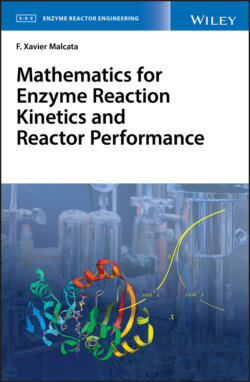Читать книгу Mathematics for Enzyme Reaction Kinetics and Reactor Performance - F. Xavier Malcata - Страница 47
4.4 Transposal of Matrices
ОглавлениеRecall again matrix A, as defined by Eqs. (4.1) and (4.2); if generic element ai,j, initially located in the ith row and jth column, were swapped with element aj,i, initially located in the jth row and ith column, then a transpose matrix would result – given by
(4.104)
in more condensed form, Eq. (4.104) reads
(4.105)
so AT will be an (n × m) matrix. The order of a square matrix is obviously not changed upon transposal – neither do the diagonal elements (characterized by i = j), irrespective of its order; hence, one finds that
(4.106)
for a square A . Furthermore, if the elements symmetrically located with regard to the main diagonal are identical, then
(4.107)
a matrix bearing this property is termed symmetric – a concept distinct from that conveyed by Eq. (4.44) that involves two matrices. A particular case of the above statement is the identity matrix – since ai,j≠i = 0 = aj,i; hence,
(4.108)
Application of Eq. (4.105) twice sequentially supports
(4.109)
which may be condensed to
(4.110)
therefore, the inverse of transposal coincides with transposal itself, as composition of the two leaves the original matrix unchanged.
When transposal is combined with addition of matrices, one obtains
(4.111)
from Eqs. (4.2) and (4.3), after direct combination with Eq. (4.105); whereas the algorithm conveyed by Eq. (4.4) gives rise to
(4.112)
A further application of Eq. (4.105) transforms Eq. (4.112) to
(4.113)
which is equivalent to
(4.114)
given by Eqs. (4.2)–(4.4); if more than two matrices are at stake, this very same rule can be iteratively applied.
In the case of product of matrices, one should write
(4.115)
based on Eqs. (4.2), (4.46), and (4.47); upon application of Eq. (4.105), one gets
(4.116)
so the row index (i.e. i) and the column index (i.e. l) should be exchanged to give
(4.117)
– where commutativity of the multiplication of scalars was meanwhile taken advantage of. A further utilization of Eq. (4.105) converts Eq. (4.117) to
(4.118)
so the definition of multiplication as per Eq. (4.47) may be applied backward to write
(4.119)
a shorter version of Eq. (4.119) reads
(4.120)
stemming from Eqs. (4.2) and (4.46). Hence, the transpose of a product of matrices equals the product of transposes of the factor matrices, effected in reverse order. As expected, this property can be likewise applied to any number of factor matrices.
If matrix A is a scalar matrix, say α In, then Eq. (4.120) still applies, viz.
(4.121)
since there are no significant off‐diagonal elements, the matrix at stake is intrinsically symmetric as per Eq. (4.107) – so one may write
(4.122)
along with Eq. (4.64). The order of placement of factors in the right‐hand side of Eq. (4.122) is, in turn, arbitrary as per Eq. (4.24) – so one ends up with
(4.123)
this is the conventional form of expressing the result of transposing the product of a scalar by a matrix, which degenerates to the product of the said scalar by the transpose matrix.
